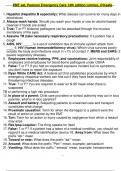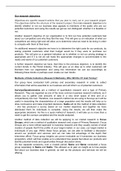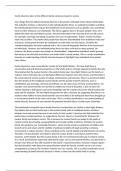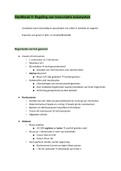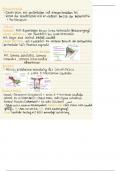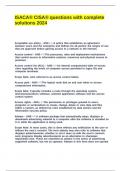The atom is the smallest part of an element that can still be recognized as the
element. It is the smallest unit of an element that cannot be broken down by
chemical reactions; it is made up of:
- Nucleus- protons and neutrons
- Orbits\ energy shells\ electron clouds- electrons
1. Atomic number: the number of protons in the nucleus of an atom
a. For an element, the atomic number is equal to the number of protons
that is equal to the mass of an electron in the neutral atom, and so
it represents the number of protons and electrons
2. Mass number: is the number of protons plus neutrons in the nucleus of
an atom.
3. Ions: charged particles that are formed when an atom loses or gains
(an) electron(s).
a. Positive ion (cation) is formed when an atom loses (an) electron(s)
so that the ion has more protons than electrons
b. Negative ion (anion) is formed when an atom gains (an) electron(s)
so that the ion has more electrons than protons
4. Isotopes: different atoms of the same element that have different mass
number; have different number of neutrons in the nucleus.
a. They have the same chemical properties; this is because they have
the same number of electrons that the chemical reactions depend on.
b. They have different physical properties; this is because their
masses differ leading to different melting and boiling points.
5. Relative atomic mass (Ar): the average of masses of the isotopes in a
naturally occurring sample of the element relative to the mass of one
twelfth of an atom of carbon-12.
6. Electromagnetic spectrum: is a spectrum of wavelengths that comprise
the various types of electromagnetic radiation; it describes the entire
range of lights that exists.
a. Electromagnetic radiation: a form of energy, which exhibits wave-
like properties. It can travel through space or matter at the speed
of light.
i. They make up the electromagnetic spectrum.
ii. The smaller the wavelength and thus the higher the frequency
the more energy the wave possesses. Electromagnetic waves have
element. It is the smallest unit of an element that cannot be broken down by
chemical reactions; it is made up of:
- Nucleus- protons and neutrons
- Orbits\ energy shells\ electron clouds- electrons
1. Atomic number: the number of protons in the nucleus of an atom
a. For an element, the atomic number is equal to the number of protons
that is equal to the mass of an electron in the neutral atom, and so
it represents the number of protons and electrons
2. Mass number: is the number of protons plus neutrons in the nucleus of
an atom.
3. Ions: charged particles that are formed when an atom loses or gains
(an) electron(s).
a. Positive ion (cation) is formed when an atom loses (an) electron(s)
so that the ion has more protons than electrons
b. Negative ion (anion) is formed when an atom gains (an) electron(s)
so that the ion has more electrons than protons
4. Isotopes: different atoms of the same element that have different mass
number; have different number of neutrons in the nucleus.
a. They have the same chemical properties; this is because they have
the same number of electrons that the chemical reactions depend on.
b. They have different physical properties; this is because their
masses differ leading to different melting and boiling points.
5. Relative atomic mass (Ar): the average of masses of the isotopes in a
naturally occurring sample of the element relative to the mass of one
twelfth of an atom of carbon-12.
6. Electromagnetic spectrum: is a spectrum of wavelengths that comprise
the various types of electromagnetic radiation; it describes the entire
range of lights that exists.
a. Electromagnetic radiation: a form of energy, which exhibits wave-
like properties. It can travel through space or matter at the speed
of light.
i. They make up the electromagnetic spectrum.
ii. The smaller the wavelength and thus the higher the frequency
the more energy the wave possesses. Electromagnetic waves have


